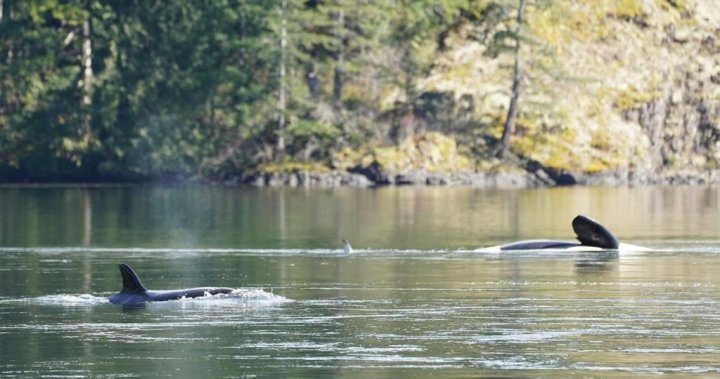Rescuers working to save an orphaned whale calf stranded near a remote Vancouver Island community have faced challenges due to low tides, limiting their ability to access the water. Fisheries and Oceans Canada officials are re-evaluating techniques used thus far and planning their next moves. The most promising tool used has been a “sound wall,” created with Oikomi metal pipes to direct the whale toward a narrow exit point across a shallow sandbar and back to open ocean. Despite the difficulties, the whale calf appears to be in good condition, and monitoring of its health is ongoing.
The two-year-old calf’s mother died in the lagoon last weekend, and efforts to free her were unsuccessful. A necropsy revealed that the 15-year-old Bigg’s killer whale was pregnant with a female fetus when she died, adding to the urgency of rescuing the calf. Various methods have been attempted to coax the calf out of the lagoon, including recorded whale calls, specialized guide lines, and the pounding of Indigenous drum beats. However, the calf has been reluctant to pass over the sandbar where its mother died, presenting a challenge to rescuers.
Scientists have been surprised by the calf’s response to whale calls, as traditional underwater playback sounds that are typically effective in attracting whales have repelled this particular calf. Efforts to use pod sounds to guide the calf towards the sandbar and open ocean have also been unsuccessful. The use of metal pipes, commonly used to deter marine mammals from approaching oil spills, has been implemented in this rescue operation. The remoteness of the location on the northwest tip of Vancouver Island has posed additional challenges, but local support from the road contractor and the Ehattesaht First Nation has been instrumental in facilitating access to the lagoon.
Rescuers are working in a highly complex and dynamic natural environment with limited time frames to effect a successful rescue of the orphaned whale calf. The shifting wind, rain, and tidal conditions add to the complexity of the operation. Despite these challenges, efforts to save the calf continue, with an emphasis on monitoring its health and exploring new methods to encourage it to leave the lagoon and return to open waters. The community of Zeballos and local contractors have provided support to the operation by making equipment and a makeshift boat ramp available for on-water access, demonstrating a collaborative effort to save the stranded whale calf.
Overall, the rescue operation for the orphaned whale calf near Zeballos on Vancouver Island is a complex and challenging endeavor. The use of innovative techniques such as the “sound wall” created with metal pipes highlights the creativity and dedication of the rescuers involved. Despite setbacks and the calf’s reluctance to leave the lagoon where its mother died, ongoing monitoring and efforts to encourage the calf to return to open ocean are in progress. The remoteness of the location and the environmental conditions further complicate the rescue efforts, but the support of local communities and indigenous groups has been instrumental in mitigating some of these challenges. As the situation continues to evolve, rescuers remain committed to finding a successful resolution for the stranded whale calf.


